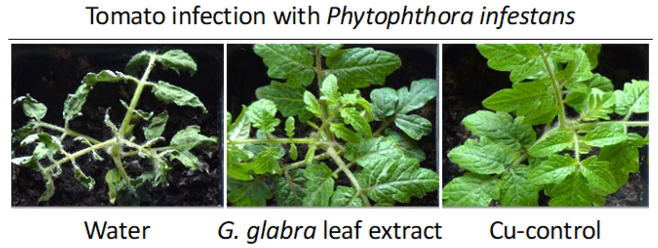Pesticides are successful in defending crop yield against plant infections, but the ecological damage to nontarget organisms has led to a struggle between conventional and organic farming methods.
 Tomato plants treated with water, Glycyrrhiza glabra leaf extract, and a Cu-based product as a control and infected with sporangia of Phytophthora infestans—assessed 7 days after challenge. Image Credit: Sophie Hermann, Marc Orlik, Petra Boevink, Elke Stein, Andrea Scherf, Ina Kleeberg, Annegret Schmitt, and Adam Schikora
Tomato plants treated with water, Glycyrrhiza glabra leaf extract, and a Cu-based product as a control and infected with sporangia of Phytophthora infestans—assessed 7 days after challenge. Image Credit: Sophie Hermann, Marc Orlik, Petra Boevink, Elke Stein, Andrea Scherf, Ina Kleeberg, Annegret Schmitt, and Adam Schikora
What is the safest, most responsible approach for growers and farmers to maintain their businesses? In response to this question, copper, a naturally occurring pesticide, has been extensively used, but discovering alternative biocontrol strategies will cut down on copper use and further support sustainable solutions.
Another interesting biocontrol option is revealed by a study by Sophie Hermann and colleagues, which was just published in Plant Disease. Researchers examined the licorice plant’s effectiveness as a pesticide since it has a wide range of positive effects on other sectors. They found that licorice leaf extract is a powerful bactericide and fungicide.
In the pharmaceutical, cosmetic, and food industries, the interest focuses primarily on roots of the licorice plant. The leaves and upper parts of the plant are byproducts and often neglected. However, we show their potential as a base for plant protection products, which may be utilized in both conventional and organic agriculture systems.”
Adam Schikora, Study Corresponding Author and Acting Head, Institute for Epidemiology and Pathogen Diagnostics, Federal Research Institute for Cultivated Plants, Julius Kühn-Institut
The researchers examined the effect of licorice leaf extract on the virulence of frequent, highly pathogenic bacteria in the model plant Arabidopsis and in tomato using plant efficacy trials.
Their findings show that salicylic acid and ethylene-based responses are both modulated by licorice leaf extract in plants’ immune reactions to pathogens. Additionally, the extract inhibits a specific oomycete that causes late blight and is resistant to metalaxyl, an active ingredient in synthetic fungicide.
These intriguing findings collectively suggest a possible strategy for managing plant diseases brought on by a wide spectrum of pathogens, such as bacteria and oomycetes.
Schikora added, “The possibility to develop biological alternatives for plant protection that are sustainable and employ otherwise unused materials will not only help in our agricultural approaches, but also support local, circular economies.”
The full potential of licorice leaf extract as an alternative plant protection strategy in the production of commercially significant crops can only be realized with further research.
Source:
Journal reference:
Hermann, S., et al. (2023). Biocontrol of Plant Diseases Using Glycyrrhiza glabra Leaf Extract. Plant Disease. doi.org/10.1094/PDIS-12-21-2813-RE